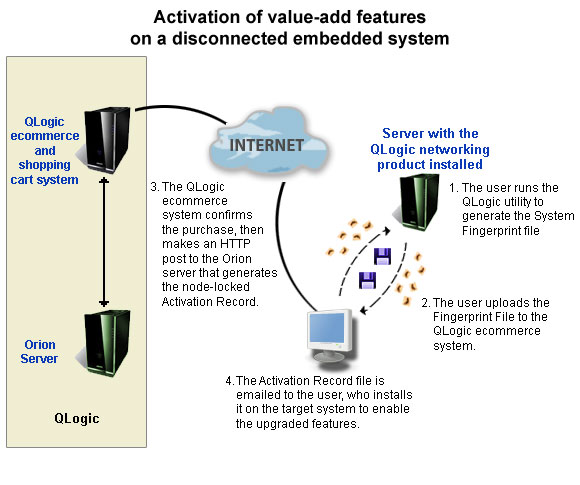Embedded System Licensing Case Study: Qlogic
QLogic (NASDAQ: QLGC) is a global leader and technology innovator in high-performance networking whose product portfolio includes Fibre Channel, iSCSI, Infiniband and Converged Network Adapters, switches, routers and ASICs. Leading OEMs and channel partners worldwide rely on QLogic products for their data, storage and server networking solutions. QLogic is a NASDAQ Global Select company and is included in the S&P 500s.
QLogic’s NX3031 10 Gigabit Ethernet Controllers and 3100-Series of Intelligent 10 Gigabit PCI Express Ethernet Adapters offer the industry’s highest performance for next-generation, mainstream server environments. Value-add features in these products, such as TCP Chimney offload capability, are protected using the Orion Network Licensing Platform from Agilis.
These embedded systems are based on flash memory with a proprietary firmware system. The first task was therefore to adapt the Orion C++ client library to run in this custom embedded system. Sanjeev Jorapur, Sr. Director of Engineering for QLogic recalls: “Our environment is simple and constrained to a very small memory footprint. However, it took us only a couple of weeks to adapt the Orion client using the supplied sample code to work in our proprietary embedded system, and to compile in C”.
In a typical product or feature activation scenario most user installations are automatically node-locked and activated via a network connection to the Orion Server, whether the Server is hosted on the Internet or installed on the customer’s global network. However QLogic’s automated activation system uses Orion’s disconnected-mode activation mechanism only, as most users’ systems don’t have network access.
Adapters are either upgraded before shipping, by QLogic’s Tier1 OEMs, or in the field by end users who purchased them from a QLogic OEM. Security and convenience were therefore of major concern. To ensure that features are enabled on the intended adapter only, the license is automatically locked to the hardware serial number of that adapter. The upgrade is accomplished by user or OEM self-service exchange of encrypted files in the following process:
- The user purchases a feature upgrade, or a pack of feature upgrades.
- The user runs a QLogic utility on the target system to generate the System Fingerprint file, an encrypted record of the hardware serial number of the adapter to be upgraded.
- The user uploads this System Fingerprint file at QLogic’s website.
- QLogic’s back-office system confirms that the purchase was approved, or subtracts one unit from that customer’s total if a pack was purchased, then makes a request to QLogic’s hosted Orion Server with the System Fingerprint file.
- The Orion Server validates the activation request, then generates and returns the encrypted Activation Record file, which includes the hardware serial number from the System Fingerprint.
- The QLogic system automatically sends the Activation Record file to the user by email.
- The Activation Record file is transferred to the adapter, where it is stored in flash.
- QLogic’s embedded system’s firmware calls the Orion client at runtime. The Orion client decrypts the Activation Record to obtain the locking and licensing parameters, so it can confirm it is running on the licensed system, and enable the purchased features.

John Nall, Manager of Web Services for QLogic, noted: “Automated delivery of features using Orion works fine, and we have had no issues. We’ve also found a single Orion Server provides very high availability – 100% uptime over the past 3 months – so we didn’t even need to use Orion’s automated fail-over capabilities.”.
QLogic also ships adapters with features already enabled. A similar process is followed in manufacturing, with their own Orion Server to manage their licenses.
“The feature activation process is transparent to our users” said Satish Lakshmanan, Director of Product Marketing for the Host Systems Group at QLogic. “Orion integrates smoothly into our backoffice to deliver a secure, automated, feature-licensing solution for our network adapters and controllers”.
